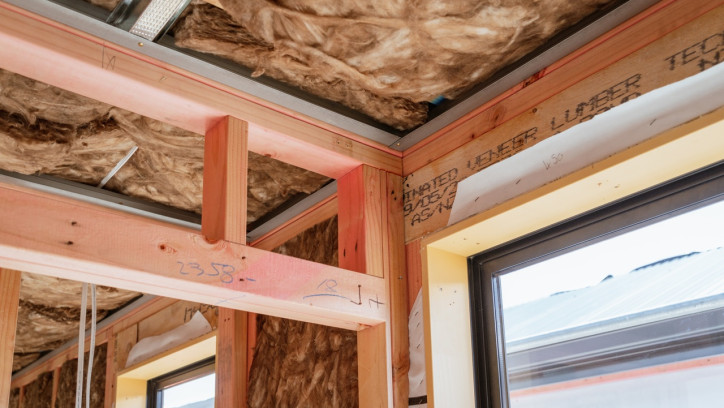H1 Energy Efficiency updates reach implementation milestone
Posted: 17 April 2023

The changes included an increase to the number of climate zones from three to six, and increased insulation requirements for roofs, walls, floors, windows, doors and skylights. They also provided a new compliance pathway for heating, ventilating and air conditioning (HVAC) systems in commercial buildings. These changes aim to deliver warmer, drier and healthier buildings that cost significantly less to heat, and generate carbon savings through improved energy efficiency.
The changes also provided a staged transition period for the insulation requirements for housing. On 1 May 2023 we will reach the next milestone in this staged transition, and will see an increase to the insulation performance requirements for new housing. The requirements are set out in tables within the H1 acceptable solution and verification method documents, and you can find a summary of the requirements and transition dates on our building.govt website.
Read about the transition dates for the H1 Energy Efficiency changes
Complying with the new requirements – new buildings
When specifying the insulation for a building project you will need to demonstrate how the building work complies with H1 Energy Efficiency. You should confirm which compliance pathway is appropriate, what construction R-values are required for the different building elements and how you can meet these. The compliance pathways and requirements are detailed in the updated versions of Acceptable Solutions H1/AS1 and AS2 and Verification Methods H1/VM1, VM2 and VM3 which were published in August 2022 on our building.govt website.
To help people understand the updated requirements, the Building Performance team have created new learning modules covering the energy efficiency requirements and the compliance pathways.
There are three modules, which start with an explanation of the requirements including the climate zones that different parts of the country fall into, the importance of insulation in buildings to increase energy efficiency, and the benefits of installing better insulation. They then cover the different compliance pathways for the Building Code’s energy efficiency requirements, including how to choose the appropriate acceptable solution or verification method for your building.
Complete the H1 energy efficiency and insulation training modules - learning.building.govt.nz
Altering an existing building
The H1 Energy Efficiency acceptable solutions and verification methods provide ways to comply with the Building Code and are straightforward to use when dealing with a brand new building. However, things get a little more complicated when you want to make an alteration or addition to an existing building.
The Building Act 2004 requires all new building work to comply with the Building Code. However, if you are carrying out building work to alter an existing building, sections 42A and 112 of the Building Act make provisions for the building to comply with the energy efficiency requirements of the building code to at least the same extent as it did immediately before the building work began. In a nutshell, the performance of the building needs to be at least as good as it was before you altered it.
So, how can you confirm that an alteration to a building will comply with the energy efficiency requirements of the Building Code?
When determining what thermal resistance is required for repaired or replaced building elements, you should consider the existing performance of the building, the extent of the element being replaced, and how the element contributes to the overall performance of the building. You can then use judgment to ensure that the replacement will perform to at least the same extent. The extent of the building envelope that is altered or replaced will influence how closely the repair/replacement should match the R-values specified for new buildings in the acceptable solutions.
For repairs or replacement of a small part of the building envelope you should simply ensure the overall thermal resistance of a building is not diminished. An example of this is the replacement of an older, single glazed window or door. The replacement joinery will need to perform to at least the same extent as the one being removed but will not be required to comply fully with the current code requirements.
For any work that alters an existing building, the main thing to remember is that the building's overall compliance with the energy efficiency requirements of the Building Code must not be less than it was prior to the alteration taking place.
Don’t miss opportunities to improve building performance
Renovations and alterations can provide once-in-a-generation opportunities to significantly improve the performance of existing buildings cost effectively. Examples are retrofitting insulation to building elements that are otherwise inaccessible, or choosing high-performance double-glazing when single-glazed windows need replacing. In such situations it makes sense to go beyond what the Building Act requires.
You can find more information about how to comply with the H1 Energy Efficiency requirements when altering an existing building on our website.
Read about H1 Energy Efficiency for alterations and additions to an existing building
Finally, there may be some situations where you need to change parts of your design once work is underway on site, including the type of insulation you are using. Specifying the R-values of your insulation at design stage, rather than specifying a particular product may help to avoid delays if this is required. If you have previously specified a particular product, and need to change this, MBIE has produced guidance on product substitution to help you through this process.
Read guidance about using a building product that differs from those originally specified
Ko te tūmanako he paku āwhina tēnei.